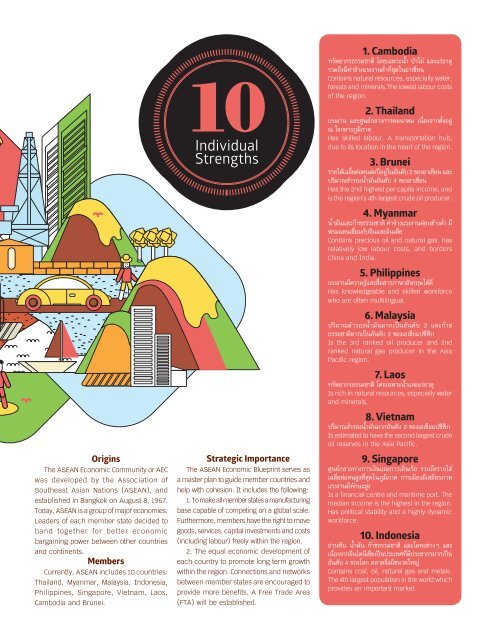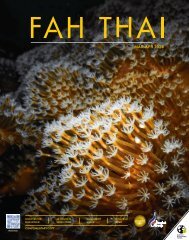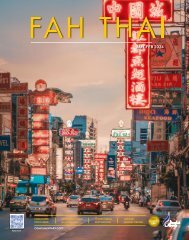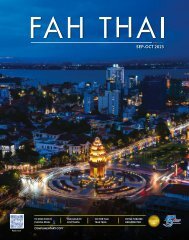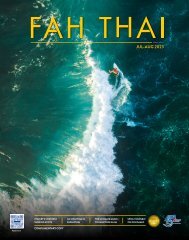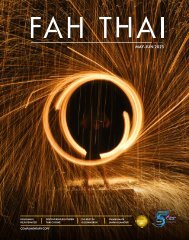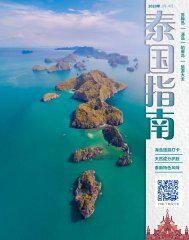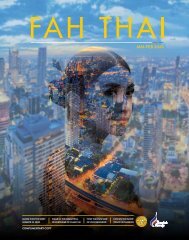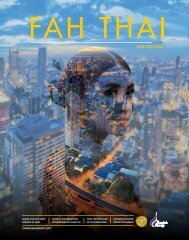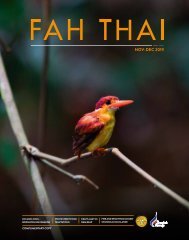WE Smile Magazine May 2015
The In-Flight Magazine of Thai Smile Airways
The In-Flight Magazine of Thai Smile Airways
You also want an ePaper? Increase the reach of your titles
YUMPU automatically turns print PDFs into web optimized ePapers that Google loves.
Origins<br />
The ASEAN Economic Community or AEC<br />
was developed by the Association of<br />
Southeast Asian Nations (ASEAN), and<br />
established in Bangkok on August 8, 1967.<br />
Today, ASEAN is a group of major economies.<br />
Leaders of each member state decided to<br />
band together for better economic<br />
bargaining power between other countries<br />
and continents.<br />
Members<br />
Currently, ASEAN includes 10 countries:<br />
Thailand, Myanmar, Malaysia, Indonesia,<br />
Philippines, Singapore, Vietnam, Laos,<br />
Cambodia and Brunei.<br />
Individual<br />
Strengths<br />
Strategic Importance<br />
The ASEAN Economic Blueprint serves as<br />
a master plan to guide member countries and<br />
help with cohesion. It includes the following:<br />
1. To make all member states a manufacturing<br />
base capable of competing on a global scale.<br />
Furthermore, members have the right to move<br />
goods, services, capital investments and costs<br />
(including labour) freely within the region.<br />
2. The equal economic development of<br />
each country to promote long term growth<br />
within the region. Connections and networks<br />
between member states are encouraged to<br />
provide more benefits. A Free Trade Area<br />
(FTA) will be established.<br />
1. Cambodia<br />
ทรัพยากรธรรมชาติ โดยเฉพาะน้ำา ป่าไม้ และแร่ธาตุ<br />
รวมถึงมีค่าจ้างแรงงานต่ำาที่สุดในอาเซียน<br />
Contains natural resources, especially water,<br />
forests and minerals.The lowest labour costs<br />
of the region.<br />
2. Thailand<br />
แรงงาน และศูนย์กลางการคมนาคม เนื่องจากตั้งอยู่<br />
ณ ใจกลางภูมิภาค<br />
Has skilled labour. A transportation hub,<br />
due to its location in the heart of the region.<br />
3. Brunei<br />
รายได้เฉลี่ยต่อคนต่อปีอยู่ในอันดับ 2 ของอาเซียน และ<br />
ปริมาณสำารองน้ำามันอันดับ 4 ของอาเซียน<br />
Has the 2nd highest per capita income, and<br />
is the region’s 4th largest crude oil producer.<br />
4. Myanmar<br />
น้ำามันและก๊าซธรรมชาติ ค่าจ้างแรงงานค่อนข้างต่ำา มี<br />
พรมแดนเชื่อมกับจีนและอินเดีย<br />
Contains precious oil and natural gas, has<br />
relatively low labour costs, and borders<br />
China and India.<br />
5. Philippines<br />
แรงงานมีความรู้และสื่อสารภาษาอังกฤษได้ดี<br />
Has knowledgeable and skilled workforce<br />
who are often multilingual.<br />
6. Malaysia<br />
ปริมาณสำารองน้ำามันมากเป็นอันดับ 3 และก๊าซ<br />
ธรรมชาติมากเป็นอันดับ 2 ของเอเชียแปซิฟิก<br />
Is the 3rd ranked oil producer and 2nd<br />
ranked natural gas producer in the Asia<br />
Pacific region.<br />
7. Laos<br />
ทรัพยากรธรรมชาติ โดยเฉพาะน้ำาและแร่ธาตุ<br />
Is rich in natural resources, especially water<br />
and minerals.<br />
8. Vietnam<br />
ปริมาณสำารองน้ำามันมากอันดับ 2 ของเอเซียแปซิฟิก<br />
Is estimated to have the second largest crude<br />
oil reserves in the Asia Pacific.<br />
9. Singapore<br />
ศูนย์กลางทางการเงินและการเดินเรือ รวมถึงรายได้<br />
เฉลี่ยต่อคนสูงที่สุดในภูมิภาค การเมืองมีเสถียรภาพ<br />
แรงงานมีทักษะสูง<br />
Is a financial centre and maritime port. The<br />
median income is the highest in the region.<br />
Has political stability and a highly dynamic<br />
workforce.<br />
10. Indonesia<br />
ถ่านหิน น้ำามัน ก๊าซธรรมชาติ และโลหะต่างๆ และ<br />
เนื่องจากอินโดนีเซียเป็นประเทศที่มีประชากรมากเป็น<br />
อันดับ 4 ของโลก ตลาดจึงมีขนาดใหญ่<br />
Contains coal, oil, natural gas and metals.<br />
The 4th largest population in the world which<br />
provides an important market.


